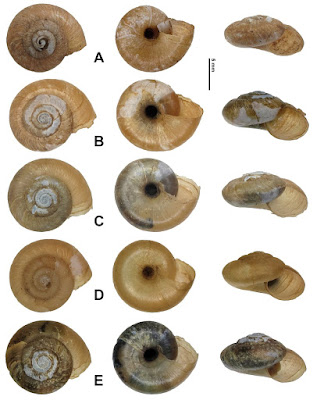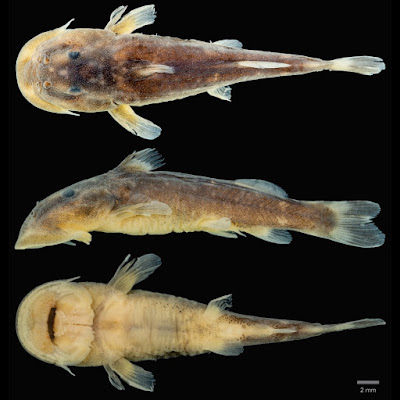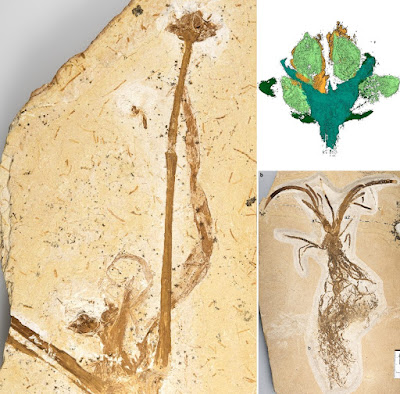[Most Recent Entries] [Calendar View]
Saturday, August 10th, 2019
| Time | Event | ||||||||
| 9:06a | [Gastropoda • 2019] Sinoxychilus melanoleucus • The First Proven Oxychilid Land Snail (Eupulmonata, Gastrodontoidea) endemic to China
Abstract A new and the first proven oxychilid species endemic to China is reported from Sichuan Province. Sinoxychilus gen. nov. is established based on this new species and has diagnostic traits of the sculptured protoconch, partial epiphallus wrapped by developed penis sheath, penial retractor muscle inserting on the top of penial caecum, spinelets on penial pilasters, absence of epiphallic papilla and perivaginal gland present on vagina and proximal bursa copulatrix duct. In light of shell morphology and through geometric morphometric analyses, Zonites scrobiculatus scrobiculatus Gredler and Z. scrobiculatus hupeina Gredler are proposed to be included in the new genus. A phylogenetic inference based on ITS2 gene indicates that the new genus is systematically close to Oxychilus Fitzinger, which is known from the Western Palearctic and the Southwestern Arabian Peninsula, regions that are geographically far from the distribution range of the new genus. Keywords: Geometric morphometric analysis, ITS2, new genus, Oxychilidae, phylogeny, Sichuan
Gastrodontoidea Tryon, 1866 Oxychilidae Hesse, 1927 Oxychilinae Hesse, 1927 Sinoxychilus gen. nov. Type species: Sinoxychilus melanoleucus gen. nov. and sp. nov. Diagnosis: Protoconch with intercrossing radial wrinkles and spiral grooves. Penis sheath developed, more or less wrapping partial epiphallus. Tubercles of broken longitudinal penial pilasters bearing spinelets. Penial retractor muscle inserting on the top of penial caecum. Neither flagellum nor epiphallic papilla present. Perivaginal gland present on vagina and proximal bursa copulatrix duct. Distribution: China (Sichuan, Hunan, Hubei). Etymology: The generic name is a compound of Greek “sino” (= China) and Oxychilus which is a genus of the family Oxychilidae.
Sinoxychilus melanoleucus gen. nov. &, sp. nov. Etymology: The species is named for the clear demarcation between the leaden black ommatophores and dorsum and the remaining creamy white body, which is reminescent of the giant panda, Ailuropoda melanoleuca by having the color pattern of clear-cut patches of black and white (Fig. 10). Ecology: The new species was found living in extremely humid environment at type locality. In the laboratory, below 100% relative humidity, animals became active at the relatively lower temperature of 5 °C (Fig. 10) before they were totally inactive at room temperature (ca. 25 °C).
Min Wu and Zhengping Liu. 2019. The First Proven Oxychilid Land Snail endemic to China (Eupulmonata, Gastrodontoidea). ZooKeys. 870: 33-50. DOI: 10.3897/zookeys.870.32903 Chinese abstract: 首次从四川青城山报道了璃螺科(Oxychilidae,癞蜗牛总科Gastrodo | ||||||||
| 9:27a | [Ichthyology • 2019] Chiloglanis mongoensis • A New Species of Suckermouth Catfish (Siluriformes: Mochokidae: Chiloglanis) from the Rio Mongo in Equatorial Guinea
Abstract A recent expedition surveyed freshwater fishes throughout the continental portion of Equatorial Guinea (Rio Muni). This portion of the Lower Guinean ichthyoprovince is relatively unknown with very few collections occurring since the 1960s. Sampling in the Rio Mongo, a tributary to the Rio Wele, yielded two Chiloglanis species; one putatively ascribed to the widespread species C. cameronensis, and the other species having similarities with C. harbinger described from the Lokoundje River in Cameroon. Morphometric analyses between the specimens from Rio Mongo and paratypes of C. harbinger confirm that they are distinct species and should be described as such. Here we describe Chiloglanis mongoensis sp. nov., a narrow endemic species only known from one locality in the Rio Mongo. We provide measurements from paratypes of C. harbinger and emphasize the need for further expeditions in the area. Keywords: Pisces, Endemism, specimen collection, allometric correction, biodiversity Chiloglanis mongoensis sp. nov. Diagnosis. Chiloglanis mongoensis is readily distinguished from all other valid species of Chiloglanis with the exception of C. marlieri and C. harbinger in possessing 28–30 (14+14 – 15+15) mandibular teeth in one row. Chiloglanis mongoensis is distinguished from C. marlieri in possessing a longer dorsal spine (1.8 times into head length versus 3.1 in C. marlieri). Chiloglanis mongoensis is distinguished from C. harbinger in having fewer premaxillary teeth (99–116 versus 150–224) arranged in fewer rows (4–5 versus 7), a longer dorsal spine (9.0–9.7 versus 7.8–9.0% SL), a deeper body at anus (14.0–16.0 versus 11.7–13.8% SL), a larger eye (3.7–4.6 versus 2.9–3.5% SL), and a higher adipose fin (2.6–3.9 versus 1.6–2.3% SL; Tables 2 and 3). Etymology. The specific epithet refers to the Rio Mongo, a tributary to the Rio Wele in Equatorial Guinea, where the species is presumed endemic. Distribution. Chiloglanis mongoensis is only known for the type locality. Upstream from the bridge crossing the Rio Mongo cascades down a bedrock outcrop that is ~3-4 meters high and ~10 meters long. Standing on this very slippery bedrock we were able to collect several specimens of C. cameronensis and C. mongoensis from cracks in the bedrock with the electrofisher. After 30 to 45 minutes we collected four C. mongoensis and five C. cameronensis specimens. Though collected in the same microhabitat; it seems likely that further, more focused, collections would reveal that these two species are occupying different habitats within the Rio Mongo. In co-occurring Chiloglanis species from the Upper Guinea Forest streams in Guinea, Conakry one species is usually found in woody debris or submerged roots while the other occupies the cobble and larger rocks in the riffles and runs (Schmidt et al. 2017b). Chiloglanis mongoensis or C. cameronensis specimens were not collected in a small tributary to the Rio Mongo, but the stream was shallow, substrate was mostly sand and gravel, and there was little flow. Ray C. Schmidt and Christian Barrientos. 2019. A New Species of Suckermouth Catfish (Mochokidae: Chiloglanis) from the Rio Mongo in Equatorial Guinea. Zootaxa. 4652(3); 507–519. DOI: 10.11646/zootaxa.4652.3.7 | ||||||||
| 9:41a | [PaleoBotany • 2019] Cratolirion bognerianum • Fossil Evidence of Core Monocots in the Early Cretaceous
Abstract All the major clades of angiosperms have a fossil record that extends back to more than 100 million years ago (Early Cretaceous), mostly in agreement with molecular dating. However, the Early Cretaceous record of monocots is very poor compared to other angiosperms. Their herbaceous nature has been invoked to explain this rarity, but biogeography could also be an explanation. Unfortunately, most of the Early Cretaceous angiosperm record comes from northern mid-latitudes. The Crato plattenkalk limestone offers a unique window into the Early Cretaceous vegetation of the tropics and has already yielded monocot fossils. Here, we describe a whole monocotyledonous plant from root to reproductive organs that is anatomically preserved. The good preservation of the fossils allowed the evaluation of reproductive, vegetative and anatomical characteristics of monocots, leading to a robust identification of this fossil as a crown monocot. Its occurrence in Northern Gondwana supports the possibility of an early radiation of monocots in the tropics. Angiosperms Monocotyledons Core monocot (Petrosaviidae, Cantino et al., 2007) incertae sedis Cratolirion Coifard, Kardjilov et Bernardes-de-Oliveira. Cratolirion bognerianum Coifard, Kardjilov et Bernardes-deOliveira. Etymology. From Crato, the locality and λείριον, leírion, Lily. The lily of Crato. Cratolirion bogneriana sp. nov. Etymology. In honour of Josef Bogner, a German botanist, for his contribution in living and fossil aroid systematics and interests in fossil monocots.
Clément Coiffard, Nikolay Kardjilov, Ingo Manke and Mary E. C. Bernardes-de-Oliveira. 2019. Fossil Evidence of Core Monocots in the Early Cretaceous. Nature Plants. 5; 691–696. DOI: 10.1038/s41477-019-0468-y Oldest completely preserved lily discovered in Brazil phys.org/news/2019-07-oldest-lily-brazil.h |
| << Previous Day |
2019/08/10 [Calendar] |
Next Day >> |










